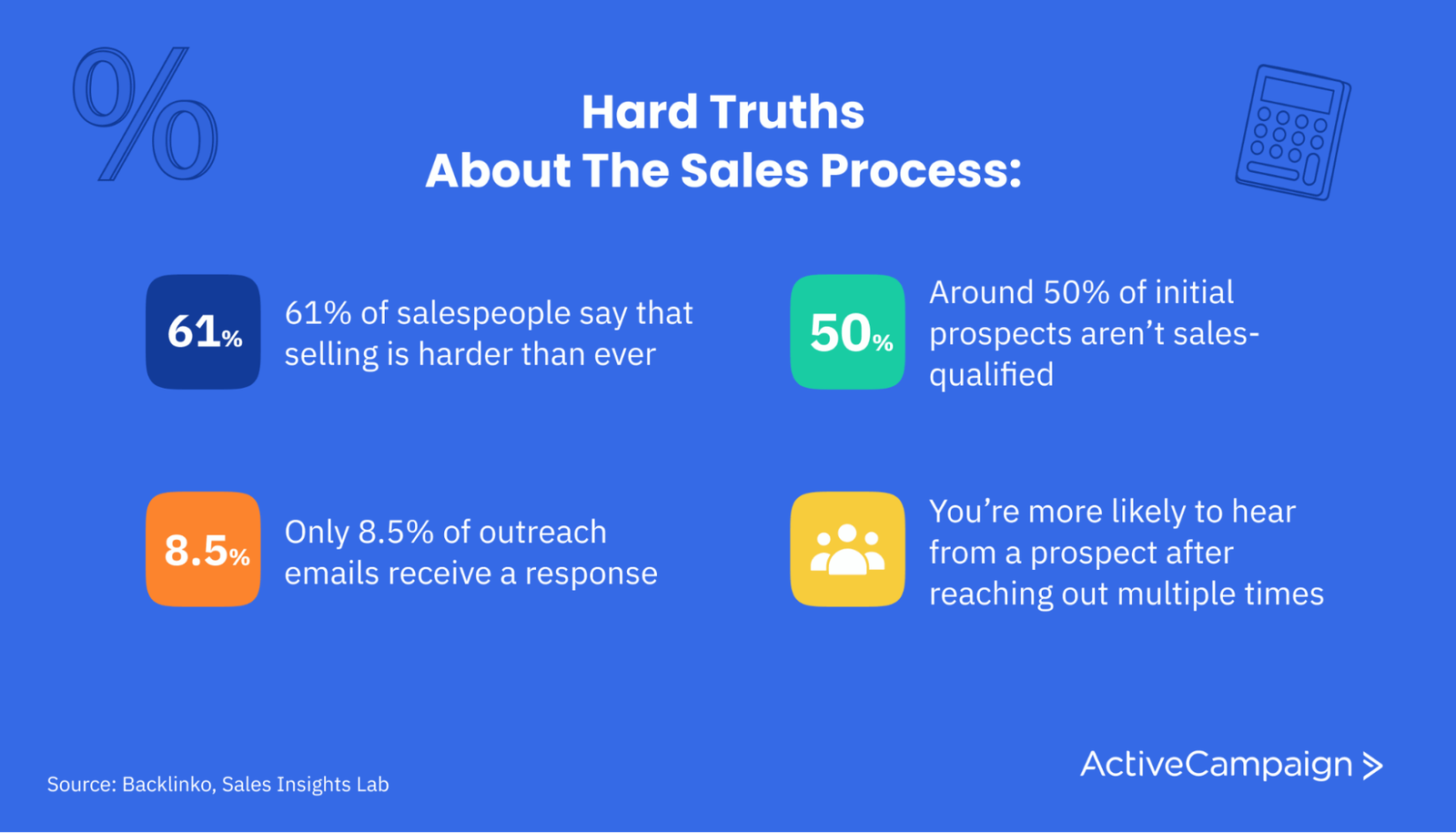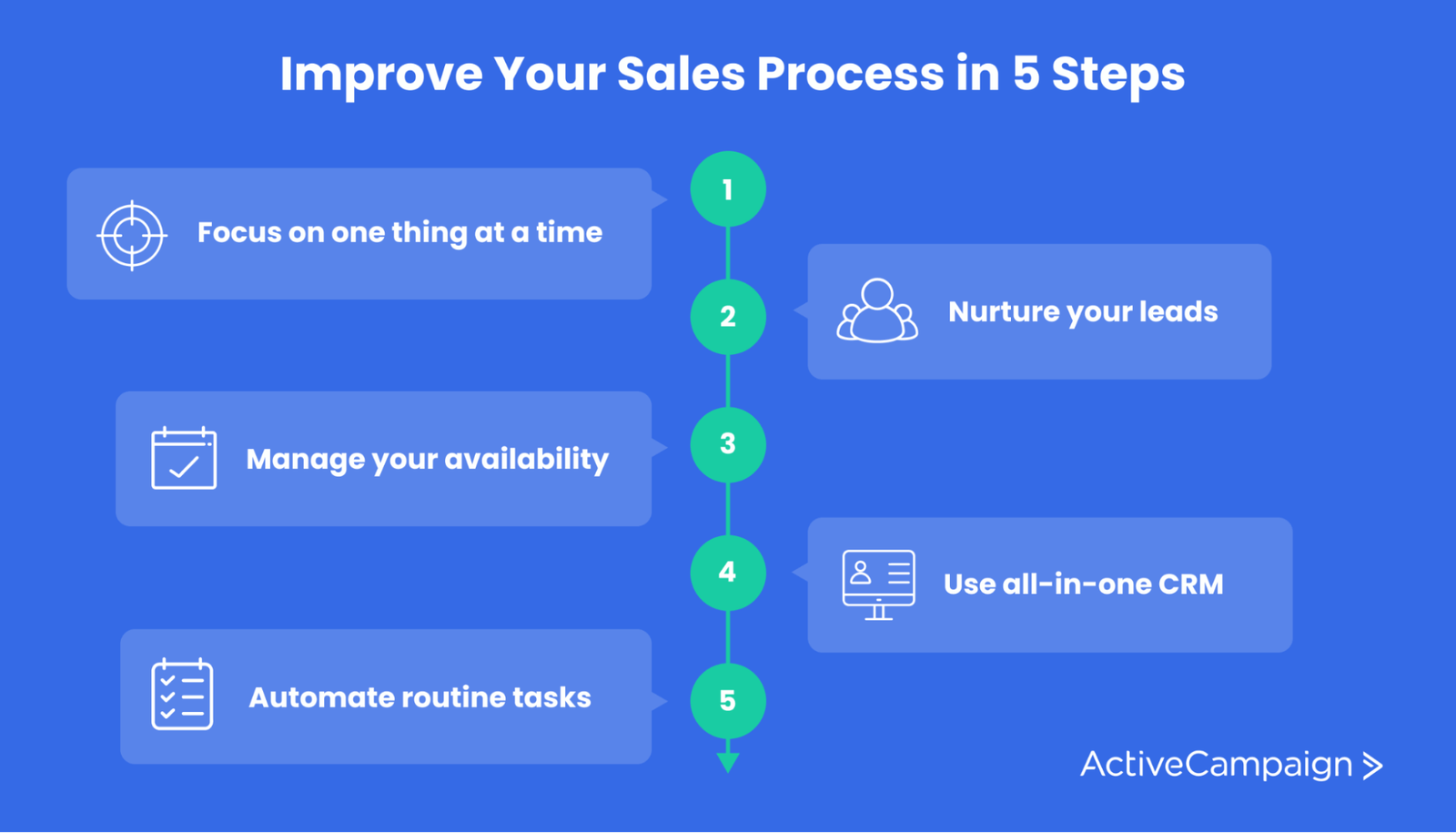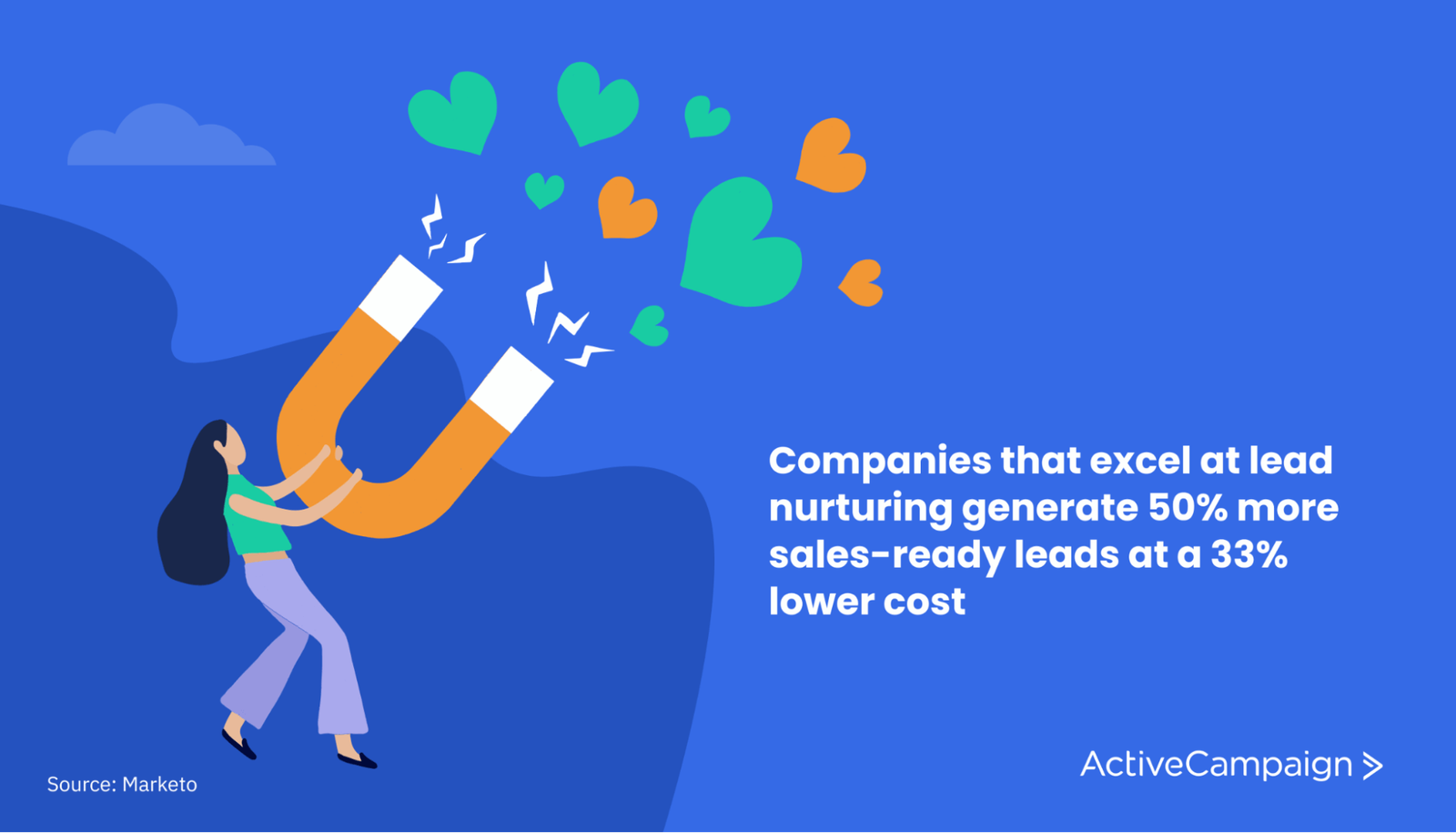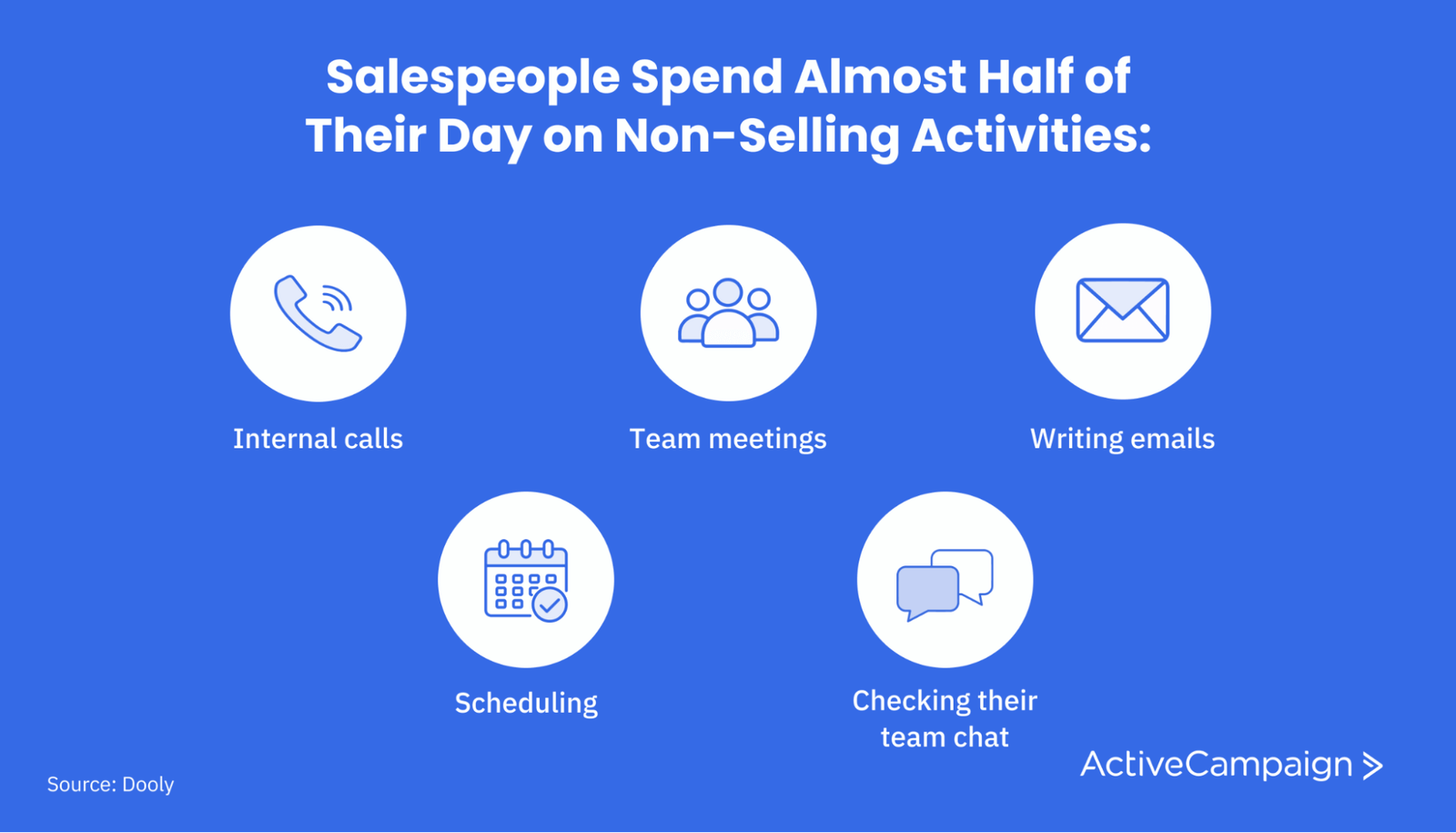From our experience as a marketing automation agency, many service-based businesses struggle with marketing and sales process automation. It’s crucial that these businesses treat their clients like people, but that personal touch is easily lost when automating sales and marketing processes. On the other hand, doing everything manually isn’t an option—salespeople can’t afford to spend the whole workday on routine tasks.
The good news is that any sales team can strike a balance between automation and personalization. This article will show you how to create a world-class automated sales process in 5 simple steps without sacrificing that personal touch.
Table of Contents
What is a sales process?
A sales process is a clearly defined framework for organizing and streamlining sales efforts. Think of it as a series of steps sales reps follow whenever they discover a new prospect.
Sales teams need a solid sales process to consistently fill their sales pipeline with high-quality leads, effectively nurture them, and close deals faster. It helps standardize sales activities without choking reps’ initiative and creativity.

Creating a proper sales process isn’t an option but a necessity—61% of sales professionals say that selling has become harder than ever; hence it’s too risky to rely on “lucky” improvisation.
Why do you need a better sales process for selling B2B services?
Selling B2B services is incredibly challenging—there’s often no physical product to show, it’s harder to articulate the value to the customer, and establishing clear success metrics isn’t always possible. Having a cohesive plan helps you overcome those challenges and turn skeptic leads into customers time after time.
But what if you already have an established sales process? Refining it is never a bad idea—81% of marketing and sales professionals say they don’t audit their sales processes frequently enough, leading to outdated or ineffective practices.
Finally, having a clear action plan enables you to onboard new sales talent faster and help them understand the specifics of selling your services.
Improve Your Sales Process With Automation
How to create a successful sales process in 5 steps
Here are 5 crucial steps to level-up your sales success:

Step 1. Focus on 1 thing at a time
Service providers usually jump straight from cold emails to the hard sell, discussing their solution before understanding if and how they can help the potential client.
The more we work with service-based businesses, the more we find that companies are happy to talk about their service and what they can offer, but rarely do they spend time listening. Patience isn’t exactly their strong suit, and that’s what hurts their sales. Don’t rush it—build trust and stay persistent.
We recommended taking a more delicate approach and turning to consultative selling. When talking with a potential buyer, you need to understand their ultimate goal and why they need you to achieve it. This process is what we call a “Discovery Session.” During this first consultation, you simply want to know if you are a fit to work together and if there’s a clear opportunity where you could help. If there is, start working on a solution. If not, move on.
This first conversation is the foot in the door and the beginning of your sales process. The rest of your sales process should also be standardized (of course, you have to be flexible, as not every sale will perfectly fit your process).
Determine how many standard conversations you want to have with a client and create a process around it. For example, you might want a maximum of 3 conversations for a process that looks like this:
- First consultation
- Follow Up
- Solution Presentation
- Sale
Once this is designed, you are on the right track to support their decision by nurturing them.
Step 2. Nurture leads and plan your follow-ups
Before you even have your first consultation, your sales process should have begun. Your first conversation will go much smoother if your prospects aren’t going in blind and have some idea of who you are and what you do.
Here’s where your nurturing process should come in. Give leads some love, send them an introduction to you and the business, a success story, and help them understand what you do and how you do it. This is all stuff that can be automated, so anytime a prospect enters your pipeline, you can automatically begin nurturing.

By the time you have that first consultation, they’ll have a good understanding of what you do, and you’ll have a better chance at conversion and driving them into the following step. Remember, always be selling for the next step in your process, not the final one.
Create highly personalized nurturing campaigns using email automation tools and share valuable content with your prospects to help them “ripen.” They’ll do their research regardless of how well you connect with them during your first call, so your content will only help them arrive at the right conclusion.
Step 3. Create boundaries and manage your availability
Something critical for any service business is to create time boundaries. As we all know, a conversation can go on too long when you connect with someone genuinely interested in finding a solution to their problem.

Keep your sales calls short and to the point—respect your time and theirs. It might seem like a good idea to keep a conversation going interminably, but in reality, if you’re not purposeful, you’ll end up wasting your valuable time.
The same goes for scheduling and other tasks not directly related to sales. Use scheduling automation and productivity tools to manage your availability and make sure that you pay enough attention to all of your prospects. It’ll help you build a strong sales process and focus on what you do best.
Step 4. Use a CRM
You can store customer and prospect data, visualize your sales pipeline, and track customer journey stages in a CRM. I strongly suggest not to keep post-it notes around your computer for when you need to make the next call—this is not a recipe for success. Use a unified system to track your sales progress.
A CRM provides crucial data on how fast your deals are moving through the stages, who’s responsible for them, and what’s needed to close them. This is critical for sales managers because it enables them to make more strategic, informed decisions.

For example, if you know that you have a high pipeline conversion rate and that your team is struggling with delivery. In that case, you can use that info to allocate resources better, improve your coaching strategy, or hire more sales professionals. On the other hand, if your pipeline is drying out, it’s time to work more on your marketing and generate more leads.
Step 5. Automate it
Once you have the process, follow-ups planned, boundaries set, and a CRM, automation is the next step. It’ll be all about putting all the above efforts into a system that sends the emails for you, delegates tasks for you, and helps you stay organized. You can go as far as to automate more than 30% of sales-related activities.
High-growth businesses are more likely to have advanced automation in place because it allows them to ditch the routine and concentrate their efforts on high-impact communications.

Here is the software you’ll need the most:
- Prospecting and outreach tools
- Scheduling tools
- Sales enablement and content management platform
- Task management tools
- CRM system
- Email marketing automation platform
- Contract automation
Make sure they all talk to each other. Look for tools that can easily integrate your CRM or invite a developer to take care of that. You want to manage your communications and sales activities from 1 place, and it’s absolutely possible with all-in-one CRMs and easy-to-integrate tools developed with popular platforms in mind.
Following the 5 steps above will not only be a boon to your pipeline but will also up your conversion rate so that you can close more deals. As you know, sales and marketing are the livelihoods of any business.
No sales, no customers—no customers, no business.
FAQ
How do I know if I need to improve my sales process?
Use sales intelligence tools to analyze your current sales process and identify weak spots and bottlenecks. Maybe your sales team is constantly overwhelmed and can’t properly process even high-quality leads. Or, maybe you don’t provide your prospects with the right content, and they leave. Either way, rely on data to find a definitive answer and start taking action.
What’s the difference between a sales process and a sales funnel?
The term sales funnel describes the customer journey from the awareness stage to the purchase. It’s an effective way to illustrate how potential customers are moving through various stages of the buying process. A sales process, in turn, is a guide for sales reps, helping them close deals more efficiently.
Do sales process and sales cycle mean the same thing?
Most of the time, these terms are used interchangeably. But some sales professionals prefer the term sales cycle to describe how long the customer journey takes. In contrast, the term sales process is reserved for describing sales methodology, steps, approaches, etc.
Conclusion
Take the first step toward automating your sales process without losing the human touch—sign up for a free trial with ActiveCampaign.
Thanks to our customizable template collection and code-free builder, you can design stunning email campaigns and automate them in minutes. And here's the best part—by signing up for a free account, you also get to try out our intuitive CRM and other sales tools and templates you didn’t know you needed.








